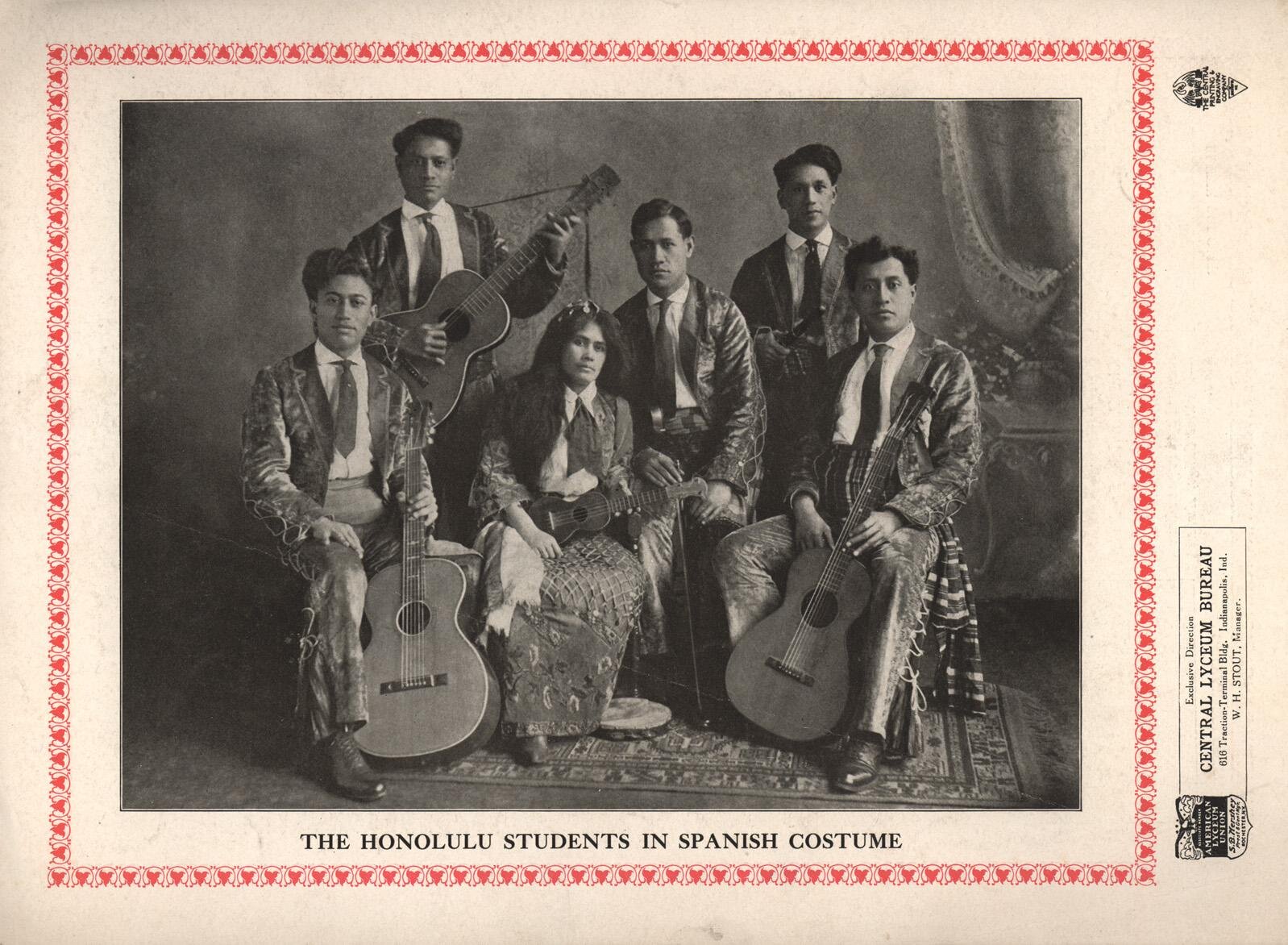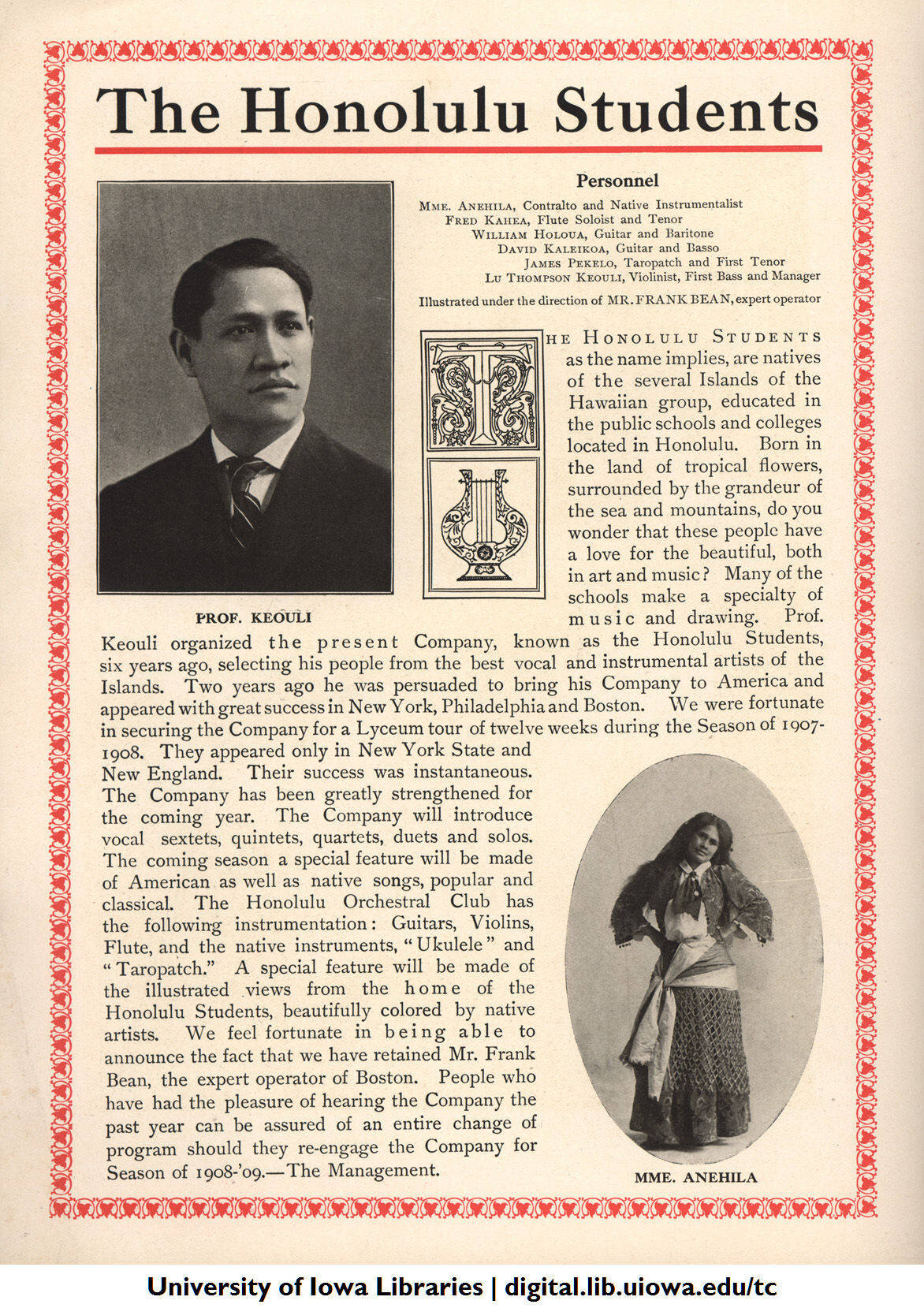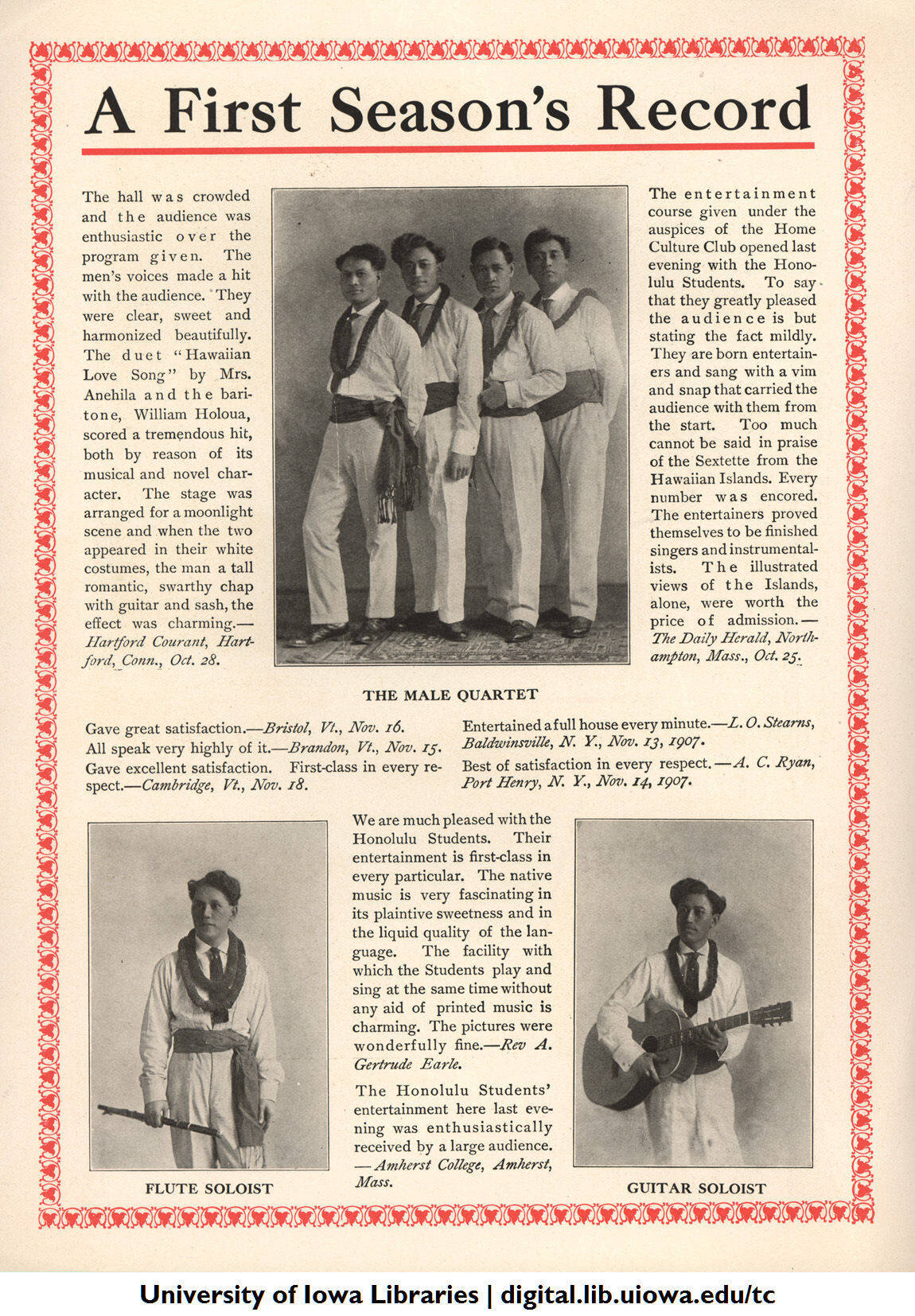Kealakai Center for Pacific Strings Fundraiser! April 5th 2019
TICKETS: http://bit.ly/sovereign-strings
I am thrilled to partner with Maile Myer, and the Puʻuhonua Society in presenting a concert of Sovereign Strings at the historic St. Andrews church, Friday April 5th! This event will be a fundraiser for the Kealakai Center for Pacific Strings, a non-profit I have founded to continue and expand the work researching and celebrating Hawaiʻiʻs legacy of excellence, innovation and influence in the world of music and luthiery.
This event will take a closer look into 19th century Honolulu and the incredible diversity of musical cultures that thrived in the kingdoms cosmopolitan capital port city of Honolulu. Tracing over a century of Hawaiʻiʻs music history through the journey of Mekia Kealakai, from his beginnings as star pupil of Prussian Kapellmeister Henry Berger at the Boys Reform School, to his international success as a music educator and virtuoso multi-instrumentalist, and finally to his return to Hawaiʻi in 1920 to lead the Royal Hawaiian Band.
Featuring a performance by the Sovereign String Band under the direction of Maestro Aaron Mahi, performing new arrangements in the old style with works by prince William Pitt Leleiōhoku and his Kawaihau Glee Club, Mekia Kealakai, David Nape, HRH Liliʻuokalani, Moʻi Kalākaua, Queen Emma, and more.
TICKETS: http://bit.ly/sovereign-strings
Sovereign String Band featuring:
Maestro Aaron Mahi- Ukulele Puka Asing- Banjo Ukulele Raiatea Helm Starr Kalahiki Blythe Kelsey Jeff Peterson- Guitar Ian OʻSullivan- Guitar & Ukulele Maikaʻi Nash- Piano Lance Suzuki- Flute Reggie Padilla- Saxophone Fumiko Wellington- Violin Rachel Saul- Violin Anna Callner- Cello Scotty Furushima- Hawaiian Steel Guitar Adam Asing- Double Bass
For those of you that were unable to attend the concerts in January, I invite you to join us for a night of food, music, community and history, in a sacred and historic space.
Papākolea style Hawaiian food by master chef Puka Asing!
A hui hou! -Kilin Reece
Royal Hawaiian Troubadors The Honolulu Students CD Released!
The recordings on this CD were made just after the turn o fthe 20th century, and have roots in an era before music had ever begun to be captured and recorded, a time when if you were not playing music yourself or listening to someone else play, you simply were not hearing music at all. They represent a time when a monumental shift in our relationship to sound was taking place, a shift that would change not only how we interact with music, but also how we relate to the people that bring music to life before us. The widespread capture and resale of sound that soon followed led directly to the birth of the musical genre- a system of classification made in the interest of marketing this newly harnessed commodity.
The extraordinary discovery of this music owes itself to an old-fashioned pilgrimage to the reading room at the American Folklife Center at the Library of Congress in Washington D.C., while researching the life of prolific Hawaiian composer and multi-instrumentalist Mekia Kealakai. A chance conversation with a gracious librarian revealed a collection of old records performed by a Hawaiian string band alternately calling itself the Royal Hawaiian Troubadors and the Honolulu Students. Born in 1882, bandleader of the Honolulu Students, Lui Thompson got his start playing in Mekia Kealakais Hawaiian orchestra on a tour across the U.S. in 1901.
Hawaiian musical ensembles began touring the continent long before there was such a thing as the “Continental United States”. For much of the 19th century, the port city of Honolulu was the largest and most cosmopolitan crossroads in the Pacific region, trading music and commercial goods extensively with the Mexican cities of Sacramento, San Francisco, Los Angeles, and Vera Cruz, as well as the Russian fur trading posts of the Alaskan territory.
At age 19, Lui Thompson performed with Kealakai playing violin at the 1901 Buffalo World’s Fair. He later recalled hearing President William McKinley’s last speech before his assassination in the music building of the fairgrounds later that day. Three years earlier, President McKinley had been instrumental in forcing the illegal annexation of the Hawaiian Kingdom through the United States Congress, making Hawai’i a U.S. Territory.
To many fans of early American “Roots” music and string bands like the Carter Family and Jimmie Rodgers, these recordings may sound curiously familiar. Jimmie and the Carters all grew up in a southern culture steeped in the influence of string-slinging Hawaiian troubadors like the ones featured in this music, and they regularly played hte Hawaiian steel guitar in their performances. These recordings were made more than twenty years before talent scout Ralph Peer, working for what would eventually become known as Victor Records, first recorded Jimmie and the Carters on his portable recording machine in 1927.
Available for the first time in 115 years, these recordings are arguably the earliest complete sessions of a traveling string band in existence. They give us a glimpse into a time when string musicians relied solely upon the strength of their hands and voices to entertain millions of listeners at Worlds Fairs, traveling tent shows and Vaudeville theaters. These songs are played by a band of young musicians on the road, recorded at the beginning of their careers, and likely in the style the composers originally intended.
The fact that this band is made up exclusively of Hawaiian musicians is a detail we believe to be worthy of deep and prolonged attention by anyone looking for the origin story of what we today call “American” music. In addition to songs written by Mekia Kealakai, this CD includes several compositions by Hawaiian royalty, including pieces by Prince William Pitt Leleiōhoku, Queen Lydia Lili’uokalani and King David Kalākaua. Their songs can still be heard today in Hula competitions, jam sessions, and in hotels along the shoreline of Waikīkī Beach.
We hope that you can find time to quiet the digital signals in your modern life and listen to the tones in these voices, the timing of the phrasing and arrangements. This music was made before America ha dever heard its own soundtrack- before there were distinctions between folk, blues, jazz, Hawaiian, hillbilly, and ethnic music. These recordings were made at a time when Hawaiian musicians like these heard here were living and traveling in America as refugees from an occupied motherland. They traveled by rail, sail and horse drawn wagon, teaching a young and fast -growing nation how to string its strings and find its voice.
Mahalo nui loa, -Kilin Reece
Early Portuguese Coconut Ukulele recreation
Agostinho de Freitas e Abreu and his grandaughter with two of his Ukulele
This is the kind of project I really enjoy these days. My historical research learning about the lives of early 19th and early 20th century musicians really makes projects that have historical significance a thrill to work on. Timothy Rajkowski grew up in Kailua, the town I am fortunate to call my home here on the island of Oahu. He approached me with this project that had great meaning to him, Tim is the family historian and geneologist as well as a member of the local Portuguese Historical Society . Tim is descended from Portuguese/Madeiran ancestors who came to the Hawaii like so many of thier country men and women seeking a better life in the then kingdom. Tim's grandfather, "Agostinho de Freitas e Abreu" was a cabinet maker to the royal family of Madeira and arrived in Maui, just before the turn of the last century. Initially working in the sugar industries cane fields, Agostinho managed to find time to build instruments for his grandaughter "Charlotte" (see photo), of which this coconut Uke was the first.
Agostinho's story mirrors that of the three most famous early stringed instrument makers to come from Madeira to Hawaii: "Augusto Dias", "Manuel Nunes", and "Jose Do Espiritu Santo", all of whom arrived to Hawaii in 1879 on a boat named the "Ravenscrag". While traveling from Madiera today would be a relatively easy jump over oceans and continents on a few airplanes, in 1879 the journey took an arduous and cramped 3 months sailing around the southern tip of south America and up the coast before sailing west to the kingdom of Hawaii. Many cite the arrival of the Ravenscrag as the first introduction of the small Portuguese stringed instrument known as the "Machete", the acknowledged ancestor to the Hawaiian Ukulele. I believe the many Portuguese and Madeiran residents of the Hawaiian kingdom, numbering over 400 according to the Hawaiian census of 1878 likely had brought with them a diversity of stringed instruments, which likely included Machetes, Braguinhas, Rajaos and Portuguese guitars.
While I have never spent a day in the tropics cutting sugar cane, I can imagine the wear and tear on ones hands and fingers after weeks, months and years cutting and processing this tough and grass like plant. The realization that these craftsmen all arrived here and spent the first 3-4 years working on sugar plantations before setting up shops building some of the smallest and most intricate stringed instruments in the world only adds to my great respect for them.
The inlay in this coconut Uke is all hand cut by Tim's grandfather, I worked solely from photographs as the original was unavailable for study. I cut in Maple and Ebony with Tagua nut (nut ivory) accents for the replica. One of the most interesting features is the profile of Abraham Lincoln for the soundhole shape. Mr. Lincoln was according to Tim one of Agostinho's heroes.
-Kilin Reece
The Hawaiian Mandolin Project
The Mandolin in 19th century Hawaii was a popular instrument, much as it was across the continental "Mainland" of the United States. Mandolin clubs, orchestras and quartets were not uncommon among many of the early Royal Hawaiian Band musical programs, and the Opera house in Honolulu regularly hosted Mandolin focused shows often led by the King of the Hawaiian Mandolin, and a leading educator of his day Ernest Kaai.
Ernest Ka'ai-Hawaiian string virtuoso- b.1881-d.1962
Mr. Ka'ai ran his own Mandolin school in Honolulu, and was said to have been the greatest of the many Hawaiian Mandolin players at the turn of the last century, reported to have been able to accompany himself in a chord melody/tremolo style all his own. Ernest went on to travel extensively throughout the world like many of his contemporaries, inspiring people everywhere he went to study Hawaiian music and dance.
Johnny Kameaaloha Almeida b.1897-d.1985
Mr. Almeidas playing stopped me dead in my tracks, with a right hand attack and tremolo rivaling any early Monroe Brothers recording, paired with the intervalic leaps and the harmonic map of Django Reinhardt, Johnny is truly one of the world wide greats in the history of Mandolin music. I happened upon a dusty box of 78s here in Kailua on the eastern side of Oahu, all of which bore the tattered labels from the 49th State label, of which I would later find out Johnny was the musical director -leading the recording sessions with his trusted mandolin. Johnny is also one of the most respected composers of Hawaiian language compositions and was a native speaker of the Hawaiian language.
Traditional Hawaiian Violin
Evidence of violins in Hawaiian music can be traced back to about 1815. The violin and flute were often the preferred instruments for melody in leading string ensembles up through the end of the 19th century, and it was not uncommon for violinists to double on mandolin. Contrary to what many string players think today, steel strings were actually less expensive than gut strings.
String Traditions of Hawai'i and the Pacific
Please visit the Kealakai Center for Pacific Strings website for more information on our historical work celebrating Hawai'i and the Pacific region's legacy in the luthiery and the musical arts.













